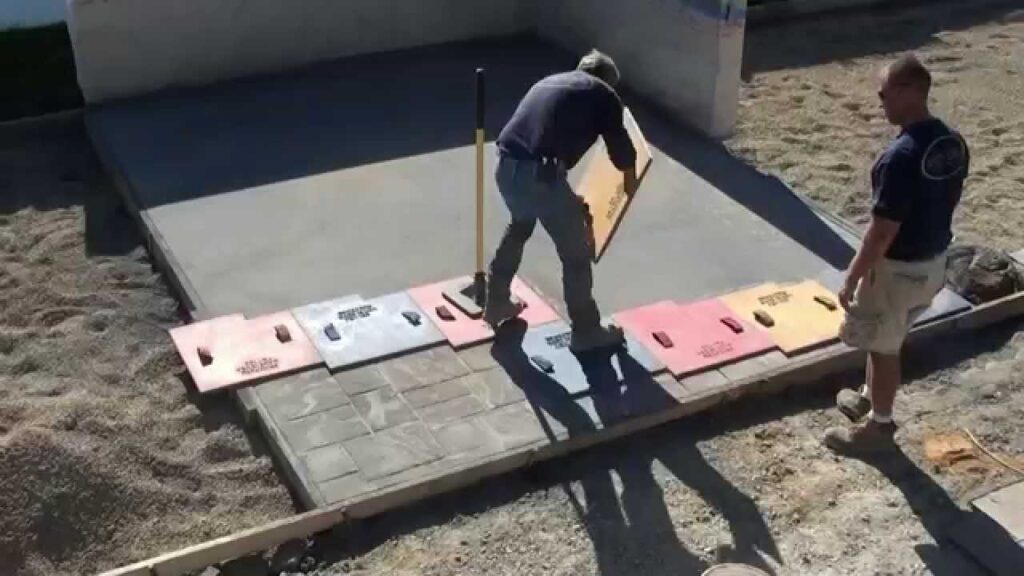

Use of STAMPED CONCRETE for Sidewalk and Footpaths and its Limitations.
Stamped concrete was a popular method of hardscaping footpaths and sidewalks in a few countries but slowly losing its popularity and being used in a very niche and fewer applications as an effective hardscaping and commercial flooring areas
Now, Precast Concrete Blocks or slabs is the most popular method of hardscaping most exterior areas like walkways, driveways, public footpaths, and even smaller public roads
The process of preparation and laying of Stamped concrete involves the preparation of a concrete sub-base sufficiently compacted and then pouring wet concrete of around 125-150mm thick. The wet concrete is troweled appropriately so that a leveled surface is attained. After the required drying time, pigments is sprayed if required and then stamps available in various sizes, shapes and face design are placed on the concrete surface. The stamps are then tamped using the right tool until the impression on the stamp is embossed on the wet concrete. This is allowed to go through the initial and complete curing period of 21 days before it is allowed for use.
The process of preparation and laying/fixing of the Precast concrete paving Blocks or slabs involves preparing a sub-base using coarse aggregates of over 100-150mm thickness depending on the application, over a pre compacted subsoil without using any cement as a binder. After compacting and leveling the sub-base, fine sand is poured over it for an average thickness of around 50mm and fine troweled to make a fine base for fixing the precast Paving Blocks. Paving blocks, which are available in various shapes and sizes is then fixed in various patterns so as to provide a perfect interlock as it is being fixed. The “Lock” is so perfect in most cases that it is almost impossible to remove an individual block on a paved surface after leveling and compacting using a device called a Plate compactor.


Comparative History
Surprisingly both stamped concrete and Cement concrete paving Blocks began their journey around the same time – which is around the ’50s. Stamped concrete was first invented and used in the ’50s and eventually became more popular in the US around the ’70s. The application was more diverse then but now is more for niche areas where intricate designs, some relating to its surroundings, etc.
However, Paving Blocks conceptually was being used by the Egyptians around 5000 years ago but were more extensively used by the Romans around 2000 years ago, which set an example to the world about its utility and long life. The Romans used cubes of stone over a compacted sub-base perfectly interlocked most of which stands even today as a testimony to their ingenuity.However, the modern version of Cement concrete precast paving Blocks was first used in Holland and for quite some time called Holland stones sized dimensionally like a brickLater lot more designs and shapes were being used based on application and preferences.Most importantly, due to its excellent property of water percolation, Paving Blocks specially shaped such that there will a sufficient gap between the blocks can be used without compromising its functionality
A few municipal corporations planning to use stamped concrete on walkways and footpaths which is now being replaced by Precast Paving Blocks in most countries including the US where it first originated. Find below the comparative chart between Stamped concrete and Precast Concrete Paving Blocks
Comparison between Precast concrete paving blocks and Stamped Concrete
| Precast concrete paving blocks | Stamped concrete |
| The process of manufacture of Precast concrete paving Blocks involves preparation of the concrete using well calibrated aggregate batching plants and planetary mixers to maintain the right water -cement ration. Since the same is prepared in closed and controlled conditions the consistency is very well maintained. This crucial phase of the manufacturing process is well monitored and automated will be immediately poured into the Concrete Block machine without any time delay so that the properties are not altered. Consequently, the Block machine uses a combination of very high vibration and Pressing techniques to produce the Blocks of various shapes and sized very accurately with close dimensional tolerances. The blocks are then automatically shifted to closed curing chambers and the entire curing process is completed in controlled conditions and then bundled and shipped to the customer sites. | Stamped concrete flooring involves a process by which wet concrete(prepared in the right proportion and water-cement ratio, slump value , transported over a distance and be able to maintain the right consistency uniformly) is poured over a well sub base and compacted concrete base and the required pigments manually sprayed in powdered or liquid form over the wet surface after a predetermined time (which can to very accurately monitored by trained and experienced workmen). The PU stamps (which needs to be cleaned and well maintained to maintain the detailing of the design) has to then be manually “stamped” using the right amount of force, again manually by trained and experienced workmen. The entire process requires skilled and responsible workmen at every stage and cannot be compromised in any manner. The surface should be well barricaded for the entire period of curing which may extend upto 21 days Only then is the Flooring ready to use. |
| Precast concrete paving blocks are manufactured under controlled conditions by fully automated manufacturing plants with very little human intervention or interference. | Since the stamped concrete is poured at site under varying conditions, climatic exposure consistent quality has to be considered and necessary actions to be taken at every stage. |
| Precast concrete paving blocks are transported to the site after it has completed the full curing process and can be safely installed at site whenever required | The concrete surface prepared at site has to be constantly monitored and well barricaded to ensure that the concrete surface is not ruined by walking over it which is very difficult to ensure especially in our roads, streets or walkways.If not maintained the concrete surface will undergo permanent damage which is irreparable |
| The quality of the product can be easily tested before installation or any time later as per the clients requirements | The quality of the concrete after the curing process cannot be easily tested since it has to be cut in cores and sent for testing which is very cumbersome and complicated |
| Any kind of depressions or undulations caused by the sinking of the base or sub-base can easily be repaired by just removing the concrete blocks, repair the base and immediately restore using the same paving blocks. | Even the most well prepared cement based base to sub-base cannot ensure that the concrete surface will develop cracks due to various factors beyond the control of the users. The gives a very bad look and feel and almost impossible to repair completely and effectively |
| Precast concrete paving blocks are manufactured with the wearing surface having the right kind of mix design and manufacturing tech ices to ensure that it can withstand very heavy pedestrian traffic and vehicular traffic easily. | The abrasion resistance of the stamped concrete surface is not sufficient for heavy pedestrian traffic or even for light vehicular traffic. The worn out surface will have lost all the design. Characteristics and exposes the base concrete which leaves a bad impression on the surface. |
| Precast concrete paving blocks available in various sizes and segment sizes held us ensure that the right paving block is chosen for the particular application and surface that can allow maximum water percolation and at the same time maintain the look and feel of the paved surface. Moreover the water percolation properties by using this product ensure that there is maximum Ground water recharging our depleted Ground water levels which is the urgent need of the hour . | Rain water percolation on a Stamped concrete surface is impossible which leads to water run-off leading to overflowing and clogged drains and into adjacent buildings leading to huge losses. |
| The cost of replacement of precast concrete blocks is very economical and user friendly. Moreover the Blocks need not be discarded and can be used again and again since they have a very long life and do not lose its properties over time. The environment – friendliness of this product is more since it does not generate any debris during the process of repair or restoration. The unique benefit is unmatched by any other product or type of flooring surface. | The overall cost of repairing or replacing a stamped concrete surface is enormously high considering the cost of demolishing the concrete using high powered tools, proper disposal of concrete debris and repairing the concrete base. The disruption of traffic for long periods of time is also a major problem |
| The process of installation of the paving blocks is much more simpler and requires lesser skilled workmen. Moreover any mistakes during this process and be easily restored and rectified without any wastage of material and very minimum cost implications This ensures that the entire process can be completed in a very cost effective manner without much losses to the contractor. | The entire process of preparation and installation of the stamped concrete flooring needs to done by trained workmen under proper supervision to ensure the that various parameters and requirements are adhered to failing which the whole process has rot be redone which is very well avoided by many contractors to save costs and minimise losses. |
| The popularity of precast concrete paving blocks is increasing due to its unmatched benefits and is the most preferred paving system in most countries world wide. | Stamped concrete flooring is being used world wide for very limited and niche applications and being replaced with precast concrete paving blocks. |

NetBet
January 4, 2022Great content! Keep up the good work!